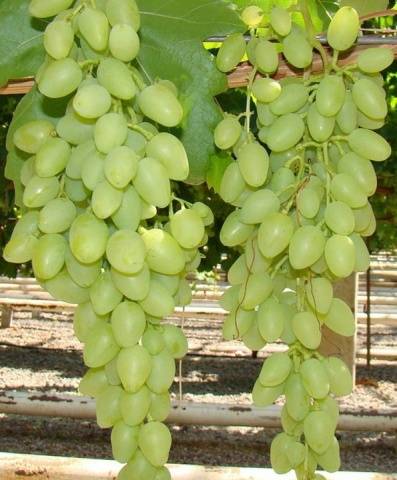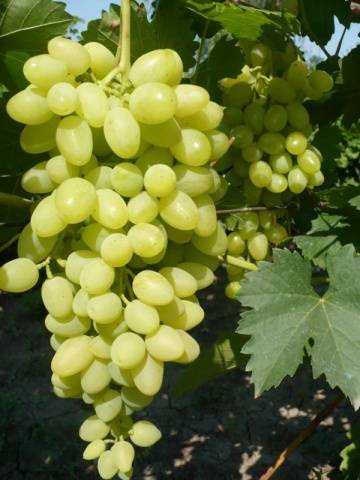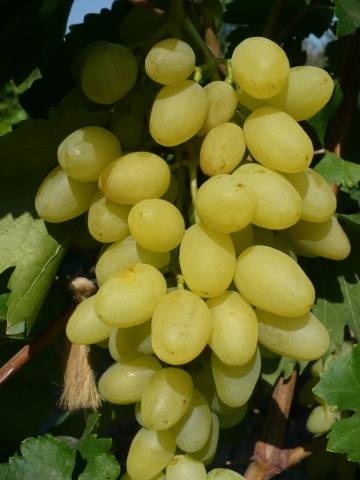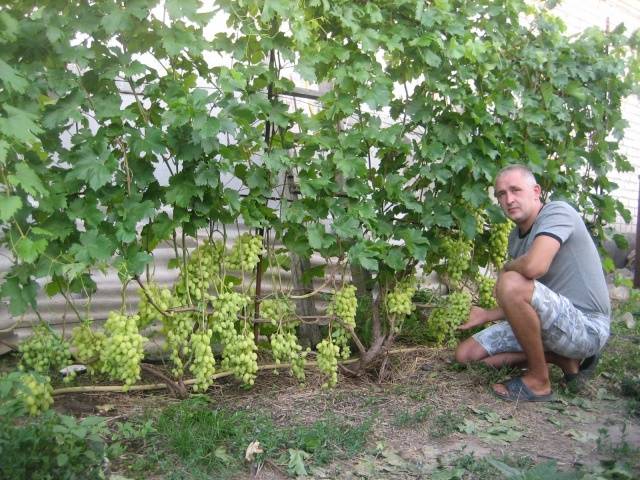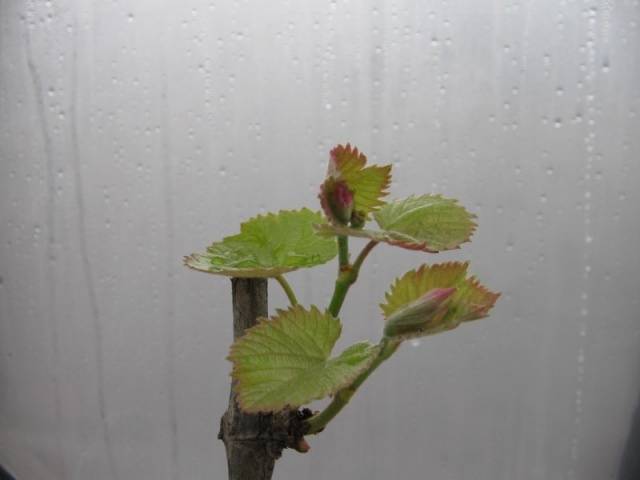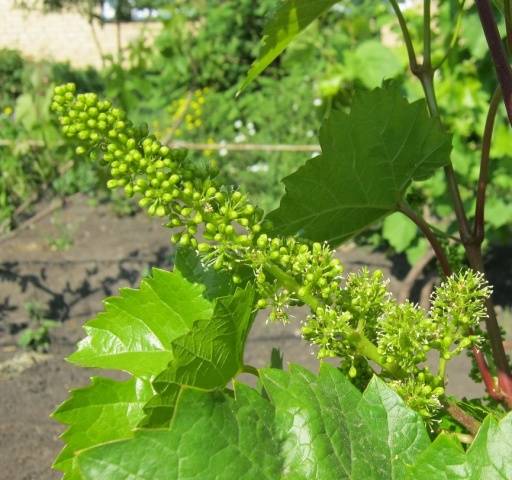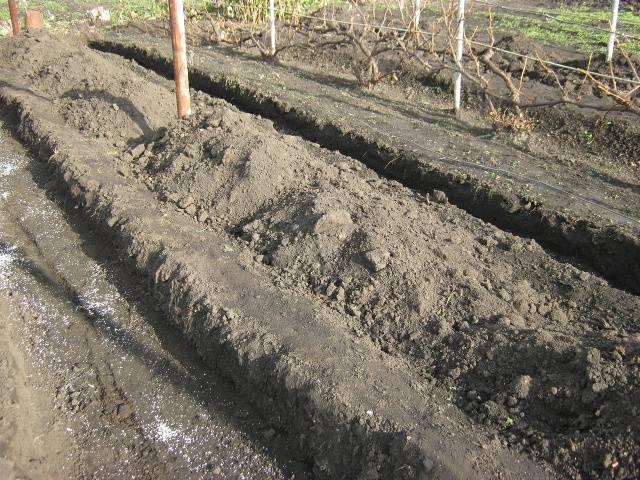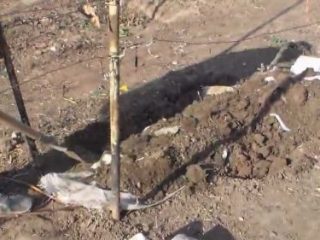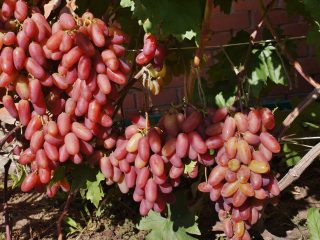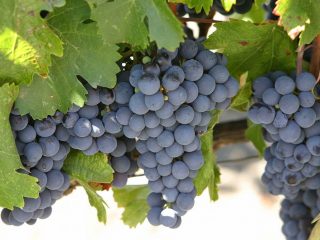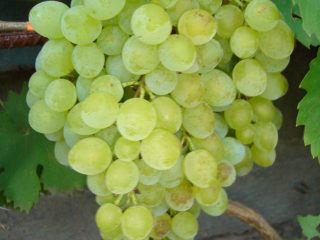Content
Early grape varieties always seem very tasty. The early ripening grapes Long-awaited, similar to raisins, combine an exquisite taste with an appetizing appearance. Lovers of large and juicy green-cream berries forgive the occasional hard seeds.
Characteristic
The long-awaited hybrid, class 4 seedlessness, was recently bred by the famous amateur breeder from Novocherkassk V.N. Krainov based on the famous varieties Talisman and Kishmish Radiant. Large-fruited, early ripening, and versatility - the long-awaited grape variety is considered not only a table delicacy, but is also suitable for making wine - making it especially popular in household plots.
Grapes can be grown not only in the southern regions of the country, but also in the middle zone. Although the Long-awaited variety is not very frost-resistant, can only withstand -23 degrees, the vine does not need a lot of sunlight to ripen. Content with the usual norm that falls on the central regions, grapes delight gardeners with beautiful, impressive bunches of sweet berries and ripened shoots. And in short summer conditions, the tops of the vine become lignified. The grapes are drought-resistant and do not like waterlogging.
Features of fruiting
According to the description of the variety, the long-awaited white grapes, after planting, reward the gardener for his care with the first harvest in 3 years. The vine blooms in mid-June, is characterized by good pollination, and belongs to the bisexual type of inflorescence. The Long-awaited variety is valued for its stable harvest and large, gracefully shaped berries, seedless or with 1-2 grains, sometimes rudimentary. The long-awaited variety is especially attractive due to its early ripening period. Grapes, according to gardeners' descriptions, very early. It ripens in 100 or 105-120 days from the beginning of the growing season, by August.
From 6 to 10 kg of tasty berries are collected from one mature vine. The Dolgozhdanny grapes exhibit partial peaing, but even small berries ripen completely. The picked bunches are stored in a cool place. In favorable weather they stay on bushes for a long time. Ripe berries of the Long-awaited grapes should be protected from rain and covered with film during watering. If exposed to rain, they crack and rot, and may crumble during transportation. In sunny, dry weather, overripe berries dry out and become very sweet.
Properties of the vine
For sufficient nutrition, the Dolgozhdanny variety needs 4-6 square meters of area. If several grape cuttings are planted nearby, the distance between them is standard: one and a half or two meters. The hybrid combines well with various rootstocks, and can itself successfully serve in this capacity. Grapes are easily propagated from cuttings. Chubuki quickly take root and take root in a new place.The development of the vine does not depend on whether it grows on a rootstock or its own root form.
The Dolgozhdanny grape, as indicated in the description of the variety, is characterized by an average sensitivity to pathogens of fungal diseases - 3.5 points. Quite often affected by oidium, but resistant to grape mites. Wasps do not usually attack the berries of this variety.
Advantages and disadvantages
The Long-awaited grape, as evidenced by reviews from gardeners, has many advantages, for which the vine is grown even on a commercial scale.
- Super early ripening;
- High marketability: attractive appearance, excellent taste, absence of seeds in the majority of berries, good yield;
- Transportability and shelf life;
- High-quality properties of the vine: cuttings quickly take root and are combined with rootstocks, shoots ripen well, male and female flowers are presented together.
The disadvantages of the Dolgozhdanny grape variety include:
- Average susceptibility to fungal diseases;
- Crop damage in case of prolonged rains;
- Presence of seeds in some berries.
Description
Medium-sized bushes of the Long-awaited grapes have powerful vines. They bear large conical clusters. The minimum mass of a bunch is 500 g, on average they weigh 700-800 g. If the requirements of agricultural technology are met, they reach a weight of 1.5-1.7 kg. The declared bunch weight is noted on the vines from the second year of fruiting. The structure of the bunch is medium dense, partly loose.
The average weight of the Long-awaited grape berries is 12 g, length 3.5 cm. Smaller ones weigh from 7 g.The berries are elongated, nipple-shaped, warm greenish-white in color, and when fully ripe acquire a transparent amber depth. The skin is thin or medium-thick, easy to eat.
The pulp is juicy, fleshy, pleasant, delicate taste, harmoniously combining the light acidity of the grapes and sweetness. Sometimes the sunny berries of the Long-awaited grape are very sweet. Hard grains are rarely found. Most often the berries are soft-seeded. Sugar content is from 17 to 22%, acidity is 7-8 g/l. The tasting assessment of the taste of berries of the Long-awaited grape variety is high: 4.5 points.
Growing
Dessert grapes The long-awaited plant in the middle zone is best planted in the spring, at the end of April. In the south, the crop is also planted in October, with good shelter. Sunny, cozy areas that are not blown by northern winds meet the requirements of the delicate vine. For grapes, you need to prepare light soil in the planting hole. You just need to avoid places where groundwater lies close to the surface.
Site preparation
The powerful vine of the Long-awaited variety requires up to 6 square meters for development. m nutrient area. In the fall, the territory is dug up with the addition of a bucket of humus and 30 g of superphosphate per square meter. Fertilizers are applied because the roots of the grapes, spreading, will feed on them for several years. On clay soils, soil is mixed with sand. For autumn planting of grapes, holes are prepared from the beginning of summer.
- Dig a planting hole with a diameter of 1 m and a depth of 0.7-0.8 m;
- The top fertile layer of soil is poured separately to prepare the nutrient mixture;
- Drainage material is laid below;
- The next layer is a mixture of fertile soil with humus or compost, to which half a bucket of wood ash and 0.5 kg of azofoska are added.
Landing
In the spring, a layer of loose top soil is placed in the hole and the seedling is carefully installed. The grapes are watered and the trunk circle is mulched;
- In the fall, a seedling of the Long-awaited variety must first be earthed up to protect it from frost;
- Seedlings from nurseries are soaked in water for a day, and before planting they are dipped in a mash of water, mullein and clay;
- Long-awaited grapes are deepened into the ground so that only two eyes remain on the surface.
Care
The author of the hybrid emphasized that individual vines require careful agricultural technology, just like the Dolgozhdanny variety. The grapes reveal their fruiting potential on strong wood, using organic and mineral fertilizers for nutrition.
- The variety is watered infrequently, except during the berry filling phase;
- In the 4th year after planting, a trench is dug along the hole into which 10-20 kg of humus is poured. The next year, a trench is dug on the other side of the bush;
- Carry out foliar feeding with complex fertilizers before and after flowering;
- Before winter, young vines are sprayed with a 3% solution of iron or copper sulfate and covered with earth. Adults - straw, spruce branches, agrofibre;
- The vines are sprayed with fungicides 2-3 times per season for prevention.
Trimming
The quality of the harvest of the Dolgozhdanny variety depends on proper pruning. The bush is created with 30-35 eyes.
- The variety is formed with a 4-armed fan;
- For the Long-awaited grape, the properties of sultanas are not regulated in any way.But annual autumn long pruning is important, in which 8-10 buds are left on each of the 20-25 shoots;
- In spring, remove damaged branches;
- In the summer, shoots that thicken the bush are constantly broken down to allow sunlight to reach the berries. Some of the leaves are also removed, which promotes ventilation and gets rid of oidium;
- The extra bunches are cut off so that the shoot does not break off, after which the vine does not bear fruit.
A wonderful vine will decorate the garden and provide early berries with a rich and harmonious taste.
